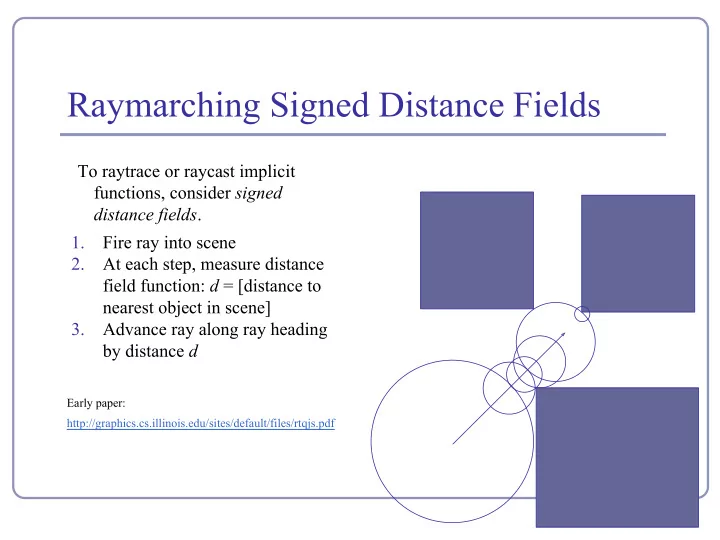

Raymarching Signed Distance Fields To raytrace or raycast implicit functions, consider signed distance fields . 1. Fire ray into scene 2. At each step, measure distance field function: d = [distance to nearest object in scene] 3. Advance ray along ray heading by distance d Early paper: http://graphics.cs.illinois.edu/sites/default/files/rtqjs.pdf
Raymarching Signed Distance Fields Sample distance functions Sample distance functions float sdSphere( float sdCylinder( vec3 p, float s) { vec3 p, vec3 c) { return length(p)-s; return length(p.xz-c.xy)- c.z; } } float sdBox( vec3 p, vec3 b) { float sdTorus( vec3 p, vec2 t) { vec3 d = abs(p) - b; vec2 q = vec2(length(p.xz)- return t.x,p.y); min(max(d.x,max(d.y,d.z)), 0.0) + length(max(d,0.0)); return length(q)-t.y; } } Source: http://iquilezles.org/www/articles/distfunctions/distfunctions.htm
Raymarching Signed Distance Fields vec3 raymarch(vec3 pos, vec3 raydir) { int step = 0; float d = getSdf(pos); while (abs(d) > 0.001 && step < 50) { pos = pos + raydir * d; d = getSdf(pos); step++; } return (step < 50) ? illuminate(pos, rayorig)) : background; }
Raymarching Signed Distance Fields Finding the normal: compute the local gradient float d = getSdf(hitpoint); vec3 normal = normalize(vec3( getSdf(vec3(pt.x + 0.0001, pt.y, pt.z)) - d, getSdf(vec3(pt.x, pt.y + 0.0001, pt.z)) - d, getSdf(vec3(pt.x, pt.y, pt.z + 0.0001)) - d));
Recommend
More recommend